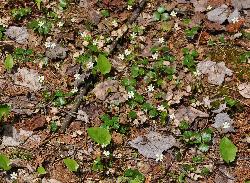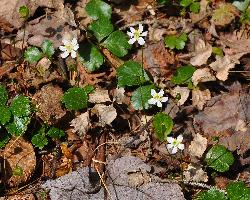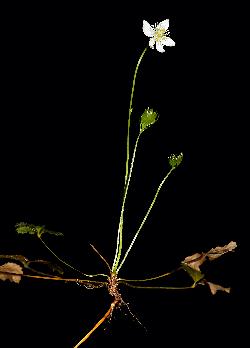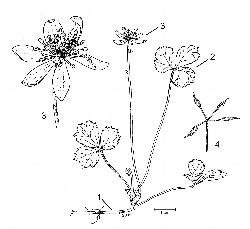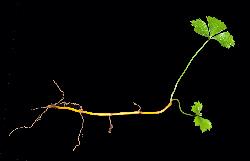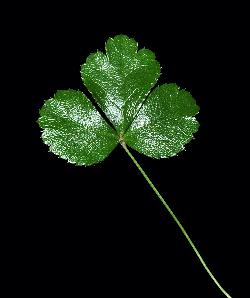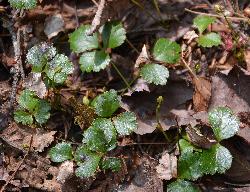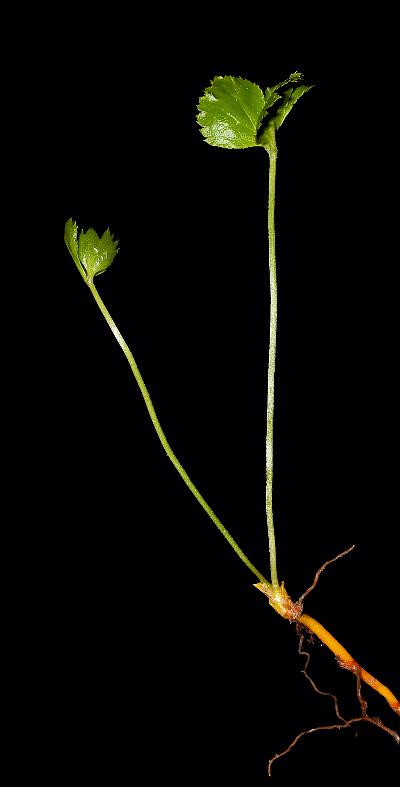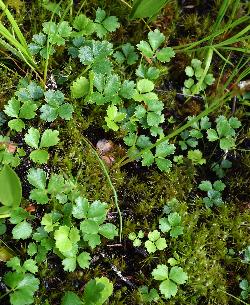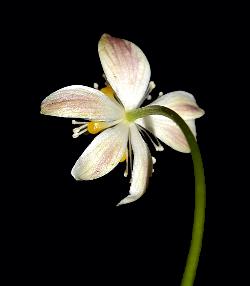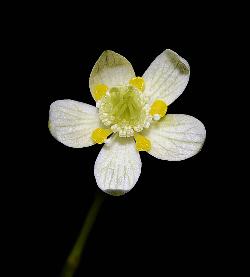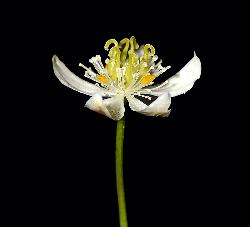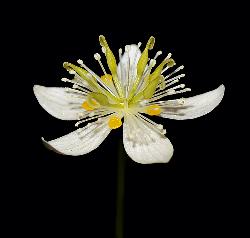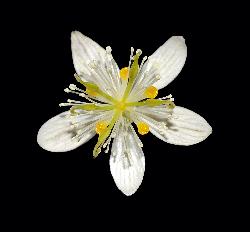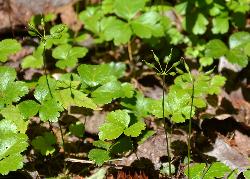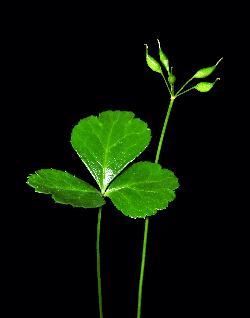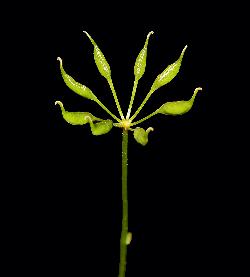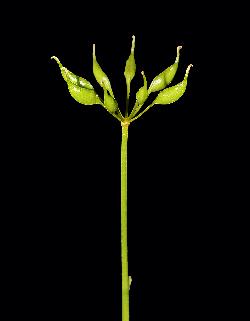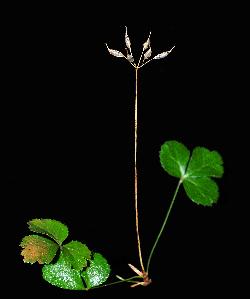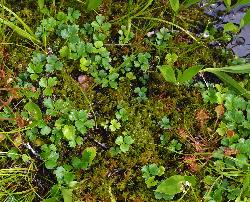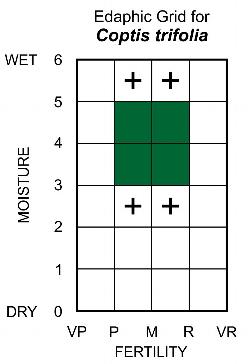Fr: savoyane, coptide trifoliolée, coptide du Groenland, herbe jaune
IA: uishakashkamiku, uishakashkamikush, uishaushkamikush
Ranunculaceae - Buttercup Family
Note: Numbers given in square brackets in the text refer to the images presented above; image numbers are displayed to the lower left of each image.
General: A low perennial glabrous herb, to 1.7 dm tall, spreading by slender rhizomes. Colonies of goldthread, with their small star-shaped flowers, are a common sight in the boreal forest understorey in spring [1–3]. Eastern North American plants were formerly known as Coptis groenlandica (Oeder) Fernald, but this species is now considered part of the broader-ranging species, Coptis trifolia, which has a circumpolar distribution.
Key Features: (numbers 1–4 refer to the illustration [4])
- Rhizomes are slender, golden-yellow to orange, and bitter-tasting.
- Leaves evergreen, basal, with 3 stiff (coriaceous), shiny, obovate leaflets.
- Flowers with 4–7 white petaloid sepals, 4–7 yellow, highly modified, nectar-secreting petals, numerous stamens, and 3–9 pistils.
- The 3–9 small fruits are ellipsoid beaked follicles that radiate out from the tip of the slender scape.
Stems: Above-ground stems are absent. The slender golden-yellow to orange rhizomes, which spread through the upper organic layer [5–6], root at the nodes and produce new vegetative shoots at the tips. The rhizomes have a bitter taste and are used in traditional medicines by First Nation healers.
Leaves: Basal, compound (trifoliolate), evergreen, and long petiolate; the slender petioles are up to 10.5 cm long. Leaves are about 0.8–1.5 cm long by 2–3.5 cm wide and have 3 obovate leaflets, slightly lobed at the apex, dark green above, and slightly paler beneath; the terminal leaflet is symmetric, while lateral leaflets are asymmetric and rounded to cordate below the midvein [7–8]. Leaflets are about 0.5–1.7 cm long; leaflet bases taper to a short stalk (petiolule), 0.5–3.5 mm long; the broad apex has marginal teeth that taper abruptly to short bristle-tips. Mature leaves have dark green, shiny, evergreen blades that persist through the winter and are present as the flower buds emerge [9]. New leaves with bright green lustrous blades emerge in spring when the flowers are fully expanded [3, 10].
Flowers: Bisexual; a solitary flower terminates a slender stalk (scape), 3–17 cm tall. Flowers are 1–1.5 cm wide with 4–7, white, petaloid sepals that are elliptic to oblanceolate, and 4–11 mm long by 1–4 mm wide; the outer surface of the sepals is often tinged pale reddish-brown [11–12]. The 4–7 petals are highly modified into fleshy yellow nectaries (nectariferous petals) that are club-shaped (clavate), narrow at the base and terminate in a broader tip with a shallow depression in the center. The petaloid sepals alternate with the shorter yellow nectaries [13–14]. The 30–60 stamens have white anthers and slender white filaments, which elongate as the anthers mature. The 3–9 green pistils each have a stalked superior ovary that tapers to a curved style that is stigmatic along one side [15–18]. Goldthread flowers are reportedly self-compatible and their nectariferous petals offer considerable nectar for pollinators (Pojar 1974a, 1974b). Pollination is by insects (entomophily); primary pollinators include solitary bees, Syrphid flies (Syrphus rubesii (L.), Melanostoma sp.), and muscid flies (Pojar 1974a, Douglas 1983, Stein 1998). Goldthread flowers bloom in mid-spring, just after marsh marigold (Caltha palustris) begins to bloom.
Fruit: A divergent cluster of 3–9 dry fruits (follicles), ellipsoid, spreading (divergent), and 4–7 mm long, excluding the beak [19–24]. Each follicle is stalked and terminates in a narrow beak, 2–4 mm long, and contains 4–8 small spherical seeds, 1–1.5 mm in diameter. Dispersal of goldthread seeds is by wind (anemochory), for short distances, and probably by the splash-cup dispersal method (hydrochory), where falling rain drops that land on the dehisced fruits push the small seeds out of each follicle (Pojar 1974a, 1974b; secondary dispersal may be provided by animals (epizoochory), who transport goldthread seeds in mud stuck to their fur or feet (Pojar 1974a).
Ecology and Habitat: Goldthread occurs in the herb layer of moist to wet, medium to rich forest sites, usually in association with feathermosses or Sphagnum mosses [25]. It rarely exceeds 10% cover and appears to be more abundant on mesotrophic sites were Sphagnum is present. It can also be found on hummocks in peatlands and in moist barren sites.
Edaphic Grid: See image [26], the Edaphic Grid for Coptis trifolia.
Forest Types: Goldthread can be found in the following forest types:
- Abietum caricetosum (Carex-Balsam Fir Forest Subassociation)
- Abietum gaultherietosum (Gaultheria-Balsam Fir Forest Subassociation)
- Abietum rubetosum (Rubus-Balsam Fir Forest Subassociation)
- Abietum taxetosum (Taxus-Balsam Fir Forest Subassociation)
- Abietum sphagnetosum (Sphagnum-Balsam Fir Subassociation)
- Alneto Piceetum (Alder-Black Spruce Swamp Association)
- Carici-Piceetum (Carex-Black Spruce Fen Association)
- Kalmio-Piceetum nemopanthetosum (Nemopanthus-Kalmia-Black Spruce Forest Subassociation)
- Kalmio-Piceetum sphagnetosum (Sphagnum-Kalmia-Black Spruce Forest Subassociation)
- Kalmio-Piceetum taxetosum (Taxus-Kalmia-Black Spruce Forest Subassociation)
- Osmundo-Piceetum (Osmunda-Black Spruce Fen Subassociation)
- Piceetum marianae (Black Spruce Forest Association)
- Sphagno-Piceetum-nemopanthetosum (Sphagnum-Nemopanthus-Black Spruce Bog Subassociation)
In Labrador, Foster (1984) includes goldthread in a group of wide-ranging species that exhibit little preference amongst the plant communities he described. Wilton (1965) does not mention goldthread in his vegetation descriptions.
Barren Types:
Goldthread occurs sporadically through most of the drier Kalmia and Empetrum barren types. However, in the moist Kalmia-Myrica and wet Kalmia Sphagnum types it occurs frequently with cover of 5–10%. In these habitats, it frequently co-occurs with the following species: Myrica gale, Aronia ×prunifolia, Chamaedaphne calyculata, Vaccinium oxycoccos, Osmundastrum cinnamomeum, and Maianthemum trifolium. Goldthread has been recorded from the following barren associations:
- Empetretum typicum (Empetrum Barrens Association)
- Vaccinietum angustifolii (Blueberry Barrens Association)
- Kalmietum angustifoliae (Kalmia Barrens Association)
- Kalmietum Myricetosum (Kalmia-Sweet Gale Barrens Association)
- Kalmietum Sphagnetosum (Kalmia-Sphagnum Barrens Association)
Peatland Types:
Goldthread occurs frequently in peatlands but usually with less than 5% cover. It frequently co-occurs with Rubus chamaemorus, Vaccinium uliginosum, Gaylussacia bigeloviana, Kalmia angustifolia, Aronia ×prunifolia, and Myrica gale. It occurs over a wide range peatland conditions including the following associations:
- Kalmio-Sphagnetum fusci (Pollett & Bridgewater 1973)
- Calamagrostio-Sphagnetum fusci (Pollett & Bridgewater 1973)
- Chamaedaphno-Sphagnetum angustifolii (Wells 1996)
- Scirpo-Sphagnetum papillosi (Pollett & Bridgewater 1973)
- Scirpo-Sphagnetum compacti (Wells 1996)
- Potentillo-Campylietum stellati (Pollett & Bridgewater 1973)
Succession: Goldthread spreads by slender rhizomes and tends to form small colonies, but little is known about its seed set or fertility (Sullivan 1992). Foster (1985) includes goldthread among those species that decrease in frequency following fire, although other studies have demonstrated that goldthread can survive light and moderate fire intensity (Sullivan 1992). Goldthread appears to require partial shade; a chronosequence study by McLean and Wien (1997) showed goldthread to be absent in early and late stages of stand development. Goldthread was rarely encountered in cutover vegetation surveyed in central Newfoundland (Northland Associates 1990).
Distribution: Goldthread is a circumboreal species that occurs throughout Newfoundland and much of Labrador, extending north to at least Nain, at 56° 30’ N (Scoggan 1978). It occurs throughout most provinces of Canada, except for the Yukon and Northwest Territories. In the United States, it occurs primarily in the northeast, extending through New England and south along mountainous areas to North Carolina, also extending northwest along the Border States to Minnesota; there is also a small disjunct range in 2 counties of Oregon (USDA, NRCS 2016).
Similar Species: Within forested habitats, there are no other species that are likely to be confused with goldthread. Since goldthread may also occur in peaty barrens or bog hummocks, its leaves could be mistaken for plumboy (Rubus arcticus L. subsp. acaulis (Michx.) Focke), but goldthread has leaves with 3 flat, glossy leaflets, while the latter species has leaves with 3 leaflets that are rugose in texture. The flowers and fruit are also quite different, with plumboy flowers having a 5-lobed calyx, 5–7 deep pink to purplish petals, and a fleshy deep red raspberry-like aggregate fruit.


